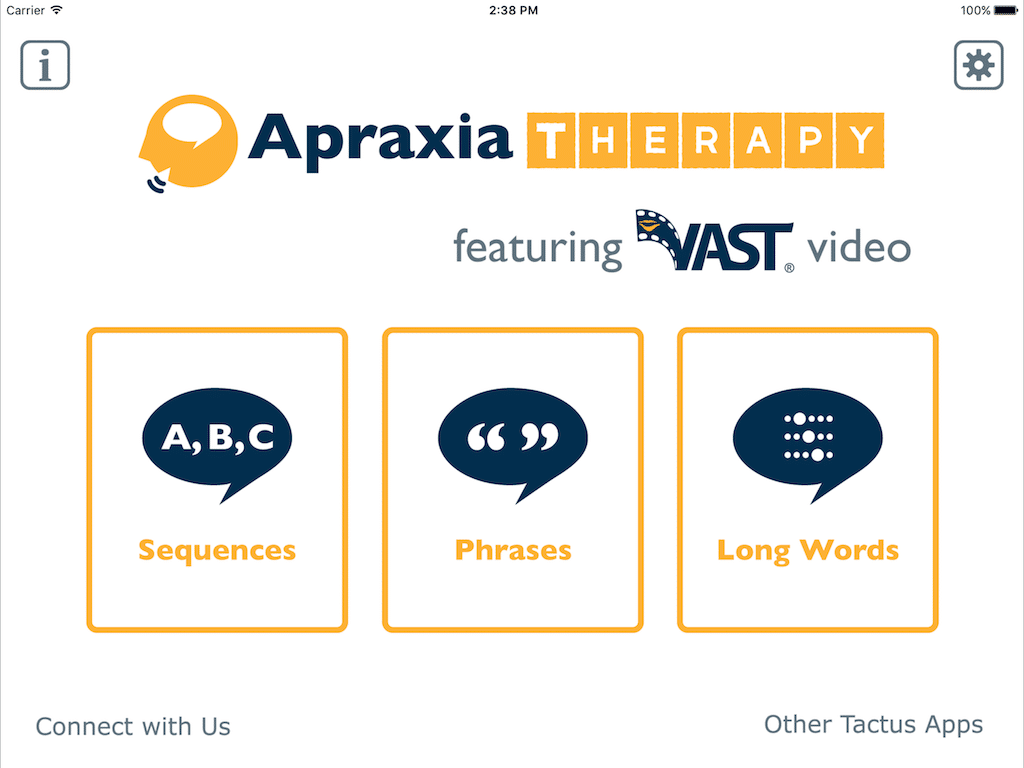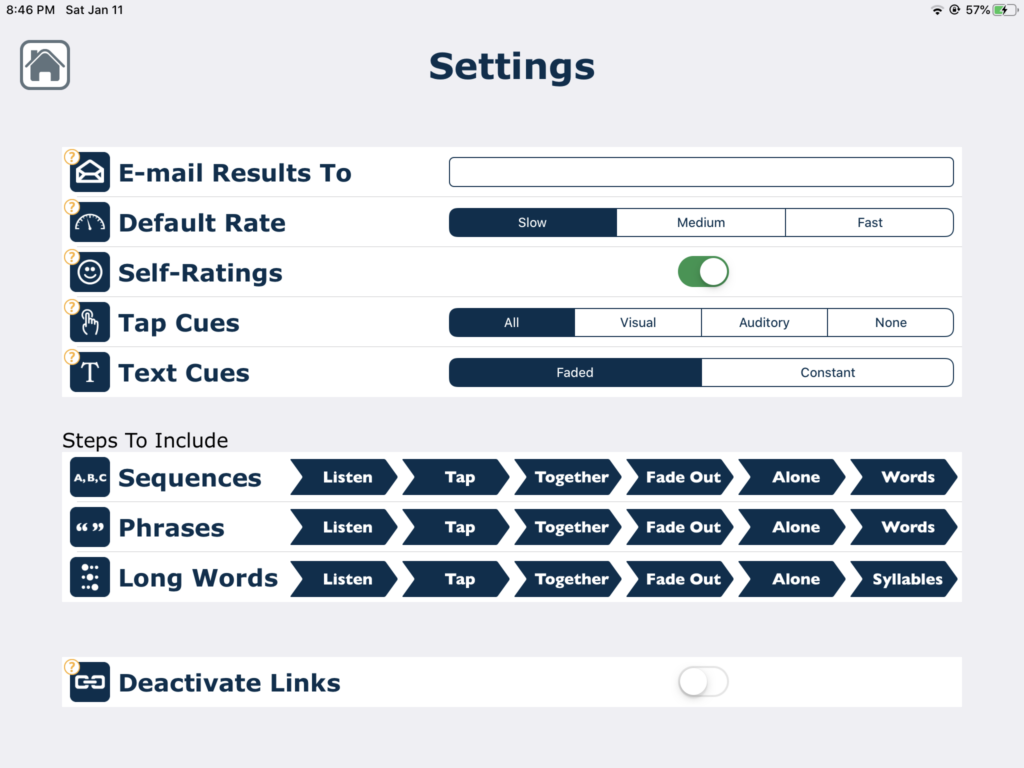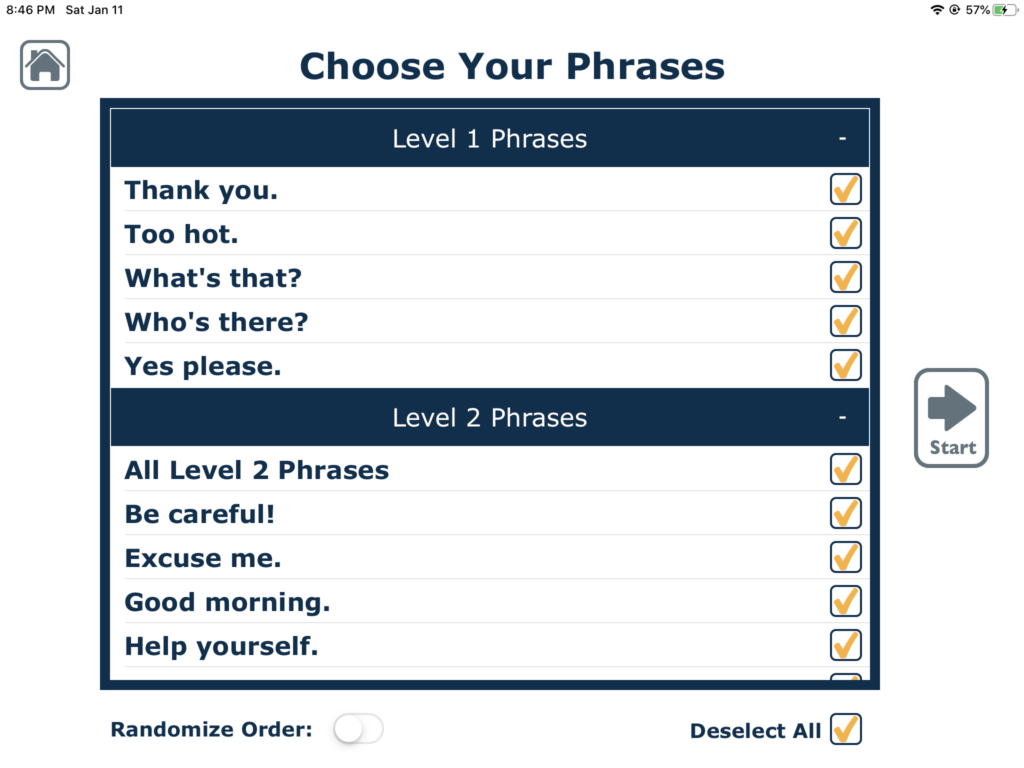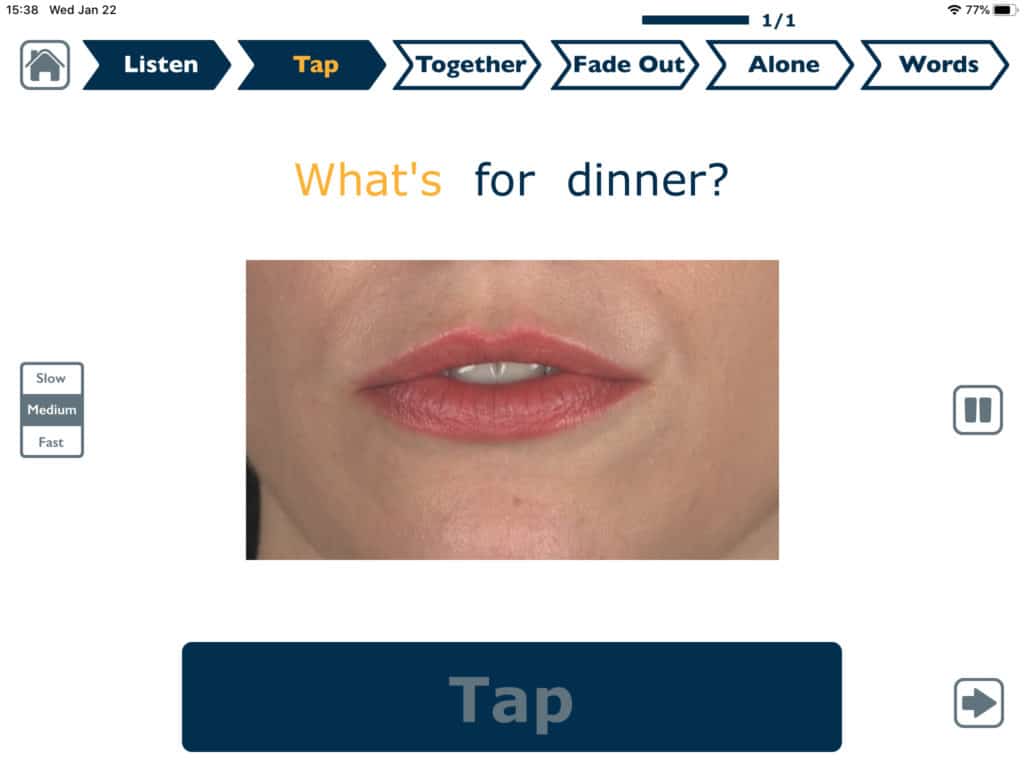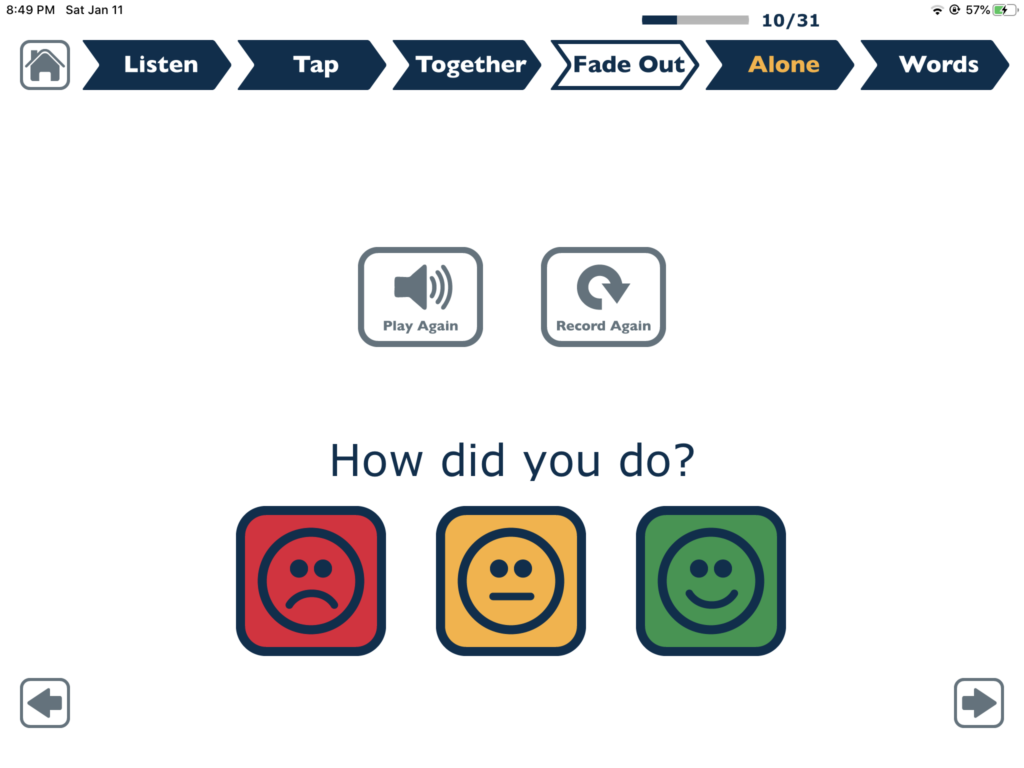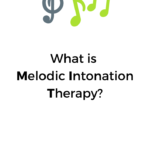How To:
Melodic Intonation Therapy (MIT)
for Severe Aphasia & Apraxia
8 min read
Have you ever encountered a person with aphasia who struggles to say their name, but can sing Happy Birthday at a family party without a problem? It’s been found that melody and rhythm can be used in a systematic way to improve verbal fluency and speech output. But don’t worry, you don’t need to be a singer to use music in speech therapy.

The Problem: Aphasia & Apraxia
Aphasia is a language disorder commonly caused by a stroke or other brain injury which impacts a person’s ability to communicate. The type and severity of aphasia are different for every person. Those with Broca’s aphasia – or non-fluent aphasia – typically have restricted verbal output, relatively good auditory comprehension, and speech that is often slow & halting.
Apraxia of speech (AOS) is a motor speech disorder that results in difficulty coordinating the muscles used to form speech. Both are commonly seen after damage to the left hemisphere of the brain.
The Treatment: Melodic Intonation Therapy (MIT)
Melodic Intonation Therapy (MIT) is an evidence-based treatment method that uses intoning (singing) to improve expressive language in people with aphasia. The approach takes advantage of the undamaged right hemisphere by engaging areas that are capable of language. It is thought that the melodic & rhythmic prosody, slower rate of articulation, and continuous voicing that result from MIT may reduce the dependence on the left hemisphere.
Who Melodic Intonation Therapy Helps
People with severe Broca’s aphasia have been found to be the best candidates for MIT. To use MIT successfully, the person must:
- Have damage to only the left hemisphere of the brain
- Demonstrate moderately good auditory comprehension
- Have non-fluent speech with effortful speech production of only a few words or only nonsense syllables
- Have poor ability to repeat even single words
- Show some ability to produce words while singing familiar songs
- Be alert, motivated, emotionally stable, and have a good attention span
Since Broca’s aphasia and apraxia are so commonly found together, it is unknown if MIT addresses aphasia, apraxia, or both.
What You’ll Need to Do Melodic Intonation Therapy
Phrases for Stimuli: Since the goal of MIT is to learn a new way to speak (not just learn & recall a set of sentences), stimuli must be abundant and varied. During the first stages, stimuli should be no longer than 4 syllables and gradually work to more complex statements made of 5+ syllables.
Put time and thought into the phrases you choose by working with your client and their caregivers to determine ones that are personally relevant. Stimuli should have a high probability of being stated in everyday conversation (e.g., if the client dislikes coffee, you would not choose the phrase “cup of coffee” to practice).
Melodic Patterns: Only 2 – 4 musical notes are to be used and should resemble natural prosody patterns. Therefore, emphasized syllables will be produced on higher notes. To make it easier, write down all the chosen phrases and sentences in order of syllable length, then underline the naturally emphasized words or syllables to determine your melody for intonation.

Key Components of Melodic Intonation Therapy
Controversy around MIT
Though Melodic Intonation Therapy has been studied over the past several decades, its effects and mechanisms continue to be questioned in reviews. Some of the challenges & controversies are as follows:
- Frequent deviations from the original MIT protocol make research studies hard to compare: Some utilize MIT as a protocol, others reduce it down to a facilitation technique with intoned speech. Other variations include mouthing of words as cues and elimination of hand-tapping altogether.
- The role of the right hemisphere: Studies have shown inconsistent findings of right hemisphere activation. However, there are several factors that can explain these differing results, including different imaging techniques, failure to use the correct protocol, no pre- and post-treatment comparisons, and individual differences.
- Aphasia v. Apraxia: Although originally thought to treat Broca’s aphasia, new research poses the hypothesis that MIT treats AOS rather than aphasia. Clinical markers of Broca’s aphasia and AOS are similar, apart from agrammatism, and MIT has shown little effect on agrammatism. Could MIT actually be more of a motor speech treatment than strictly a language treatment?
There are other music-based therapies offered to stroke survivors that are not MIT, but are often grouped with it. This article explains the protocol most speech-language pathologists use to provide Melodic Intonation Therapy.
How To Do Melodic Intonation Therapy (MIT)






Download a “How To” guide now!
Think this method might be useful? Get your free 2-page PDF handout of How To Do Melodic Intonation Therapy (MIT).
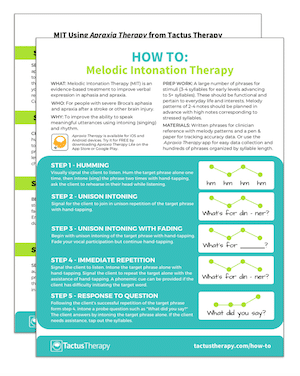
In addition to receiving your free download, you will also be added to our mailing list. You can unsubscribe at any time. Please make sure you read our Privacy Policy and Terms & Conditions.
MIT Using the Apraxia Therapy App
Tactus Therapy’s Apraxia Therapy app incorporates several of the key principles of MIT including slow & prosodic speech, hand-tapping, and changes in length and complexity of stimuli using functional phrases. Using this app at home can give people with aphasia a chance to practice speaking using highly-intoned speech in unison with a model that fades out, just like MIT performed by a clinician.
Bonus features of using the Apraxia Therapy app:
- Keep the text visible: While the MIT protocol doesn’t include the client reading the text at all, the app has the option to keep the text cues constantly on the screen if needed, and then switch to fading them out in the final steps. If you don’t want to see the text at all, position a thick piece of paper or sticky notes over the top portion of the screen to block the text from view.
- Adjust rate: You can make the video go a bit faster or slower as needed in the settings.
- Try it for free: Download the Apraxia Therapy Lite app to get 1 phrase in each level. That’s 3 phrases to get you started with MIT right away!
Apraxia Therapy
Speak more easily and build independence with video-assisted speech therapy to help people with apraxia after a stroke.
Resources for Melodic Intonation Therapy
Melodic Intonation Therapy has been used by speech-language pathologists since the 1970s when Nancy Helm-Estabrooks, Martin Albert, and Robert Sparks developed the protocol. MIT is one of the most well-researched treatments for severely impaired verbal expression related to aphasia. Nancy Helm-Estabrooks used to offer a now-discontinued Melodic Intonation Therapy Kit, including examples of MIT at each level and other benefits. Her book Manual of Aphasia and Aphasia Therapy (3rd Edition) has a complete chapter dedicated to MIT with scoring and goal examples. A detailed overview with sample stimuli and data trackers is also available from Neuro Speech Solutions.
Selected research articles on MIT:
- Norton, A., Zipse, L., Marchina, S., & Schlaug, G. (2009). Melodic intonation therapy: Shared insights on how it is done and why it might help. Annals of the New York Academy of Sciences, 1169, 431–436.
- Schlaug, G., Marchina, S., & Norton, A. (2008). From Singing to Speaking: Why Singing May Lead to Recovery of Expressive Language Function in Patients with Broca’s Aphasia. Music Perception: An Interdisciplinary Journal, 25(4), 315–323.
- Sparks, R. W. “Melodic Intonation Therapy.” Language Intervention Strategies in Aphasia and Related Neurogenic Communication Disorders, edited by Roberta Chapey, 5th ed., Lippincott Williams & Wilkins, 2008, pp. 837–851.
- Sparks, R. W., & Holland, A. L. (1976). Method: Melodic intonation therapy for aphasia. Journal of Speech and Hearing Disorders, 41(3), 287–297.
- Van der Meulen, I., van de Sandt-Koenderman, M. E., & Ribbers, G. M. (2012). Melodic Intonation Therapy: Present Controversies and Future Opportunities. Archives of Physical Medicine and Rehabilitation, 93, 46–52.
- Zumbansen, A., Peretz, I., & Hébert, S. (2014). Melodic Intonation Therapy: Back to Basics for Future Research. Frontiers in Neurology, 5.
